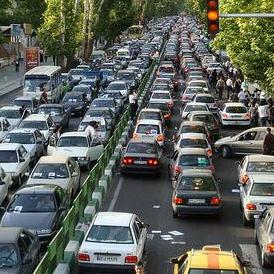 伊朗野心勃勃地想要以合成汽油產品攻占市場的計畫可能引起生態問題的挑戰。伊朗當局表示該國正逐漸朝向汽油自給自足的方向邁進,以抵擋進一步的經濟制裁。但是這樣的努力引來伊朗內部許多批評,這些批評指出,以化學品代替原油來製造汽油是不合經濟效益而且不環保的方法。
伊朗野心勃勃地想要以合成汽油產品攻占市場的計畫可能引起生態問題的挑戰。伊朗當局表示該國正逐漸朝向汽油自給自足的方向邁進,以抵擋進一步的經濟制裁。但是這樣的努力引來伊朗內部許多批評,這些批評指出,以化學品代替原油來製造汽油是不合經濟效益而且不環保的方法。
最近五個月以來,伊朗政府持續表示,由於伊朗兩年來增加汽油產量的努力,該國已經不需仰賴進口石油,也降低了國際間對伊朗的燃料制裁所造成的衝擊。
在2月4日星期五的祈禱講道上,伊朗最高領袖哈梅內伊( Ayatollah Ali Khamenei)表示,截至2月11日,也就是1979年伊斯蘭革命紀念日,伊朗已不再需要進口,甚至有能力出口汽油。
國際間紛紛表達對伊朗提出更進一步的制裁計畫,以迫使伊朗同意讓其他各國針對其具爭議性的核計畫進行審查。在可能提出的制裁的手段中,最可能被採取的即為停止對該國輸出所有的燃料。
面對如此嚴厲的威脅下,伊朗政府已經持續努力提高產能。
伊朗政府提高產能的計畫已經在2009年總統大選競選宣傳活動時公布,總統大選由阿瑪迪內賈(Mahmoud Ahmadinejad)贏得大選,但也引發廣大的示威。
增加燃料產能的計畫中,主要的一部分包括了重新設計位於馬赫沙爾(Mahshahr)與阿薩魯葉(Assalouyeh)原有的天然氣廠房,以利用這些廠房生產合成汽油。真正的生產製程則從2010年9月才正式開始,由這兩個廠房生產的燃料則在之後的數月陸續進入市場販售。
伊朗最高領袖哈梅內伊表示這個策略的改變已經成功執行。
他表示,「西方世界對汽油產品提出的制裁手段反而讓伊朗受益。」
然而,這個計劃受到來自各方的批評,有些人士提出以此產製汽油的方式缺乏效率,有些人士則認為在該廠房以合成方式製造汽油的方法不環保。
這個由天然氣廠房到燃料製造的轉變,導致了某些以石化為主成分的成品出現短缺的現象,例如油漆。
將合成汽油引入市場的作法也引起了廣大的抱怨,這些抱怨來自交通汙染,特別是在受到長期煙霧問題困擾的伊朗首都德黑蘭。
 在伊朗煉油廠以蒸餾原油產製的燃料都符合國際標準的規格製造,產製的燃料中降低了芳香族物質的濃度,例如苯,這是個目前已知會造成汙染的物質。而在石化廠產製出來的燃料則沒有這樣的特質,因為石化廠缺乏移除這些成分的能力。
在伊朗煉油廠以蒸餾原油產製的燃料都符合國際標準的規格製造,產製的燃料中降低了芳香族物質的濃度,例如苯,這是個目前已知會造成汙染的物質。而在石化廠產製出來的燃料則沒有這樣的特質,因為石化廠缺乏移除這些成分的能力。
伊朗議會以及兩個主要的監督機構,總檢察組織(General Inspection Organisation)與最高審計法院(Supreme Audit Court)皆已經下了結論,認定新的燃料就是高汙染濃度的元兇。
在去年12月初辯論最激烈時,議會成員納里曼(Mohsen Nariman)曾表示合成燃料已經造成異常高的汙染濃度,導致德黑蘭整個城市不得不在去年冬天數度全面停擺。
伊朗國營石油企業(National Iranian Oil Refining and Distribution Company, NIORDC)的工程師索黑勒(Soheil)同意這樣的看法,他解釋,合成燃料中的高濃度芳香化合物讓燃料沒有辦法在引擎中完全燃燒,因此造成更多未燃燒的物質進入大氣。
儘管石化工業的官員爭論它們的產品辛烷值至少跟傳統汽油一樣高時,索黑勒則指出這些都是未經證實的聲明。
他說,「我們進行過研究,而且發現大部分的合成燃料連85%的辛烷值都達不到。」
索黑勒表示,「就算是伊朗的煉油廠要製造出90%辛烷的燃料都有困難,因此我很難相信石化廠製造的燃料辛烷值可以超過90。合成燃料中高濃度的苯與其他的芳香化合物加劇了空氣汙染,並且提高了致癌的風險。」
石油部長卡薩米(Masoud Mir-Kazemi)對這些批評則反擊,指控這些批評者都有和西方世界的利益掛勾。
他表示,「這樣的聲明根源自伊朗境外,並且反映出了西方世界持續想要對伊朗提出燃料制裁的攻擊態度。」
邏輯上而言,像伊朗這樣的主要原油出產國,要從石油提煉出國內所需的燃料應該沒有問題。
在前任總統卡塔米(Khatami)執政時期,他則認為直接進口已經提煉的燃料比在境內製造更划算。
2005年阿瑪迪內賈掌權後改變了這個策略,並且制訂計畫以提升煉油的能力。在阿巴斯港蓋了新的波灣之星(Persian Gulf Star)煉油廠,政府官員當時都表示新的煉油廠將可以讓伊朗自給自足。
在去年的六月,石油部的副部長雷札米(Ali-Reza Zaeighami)表示建廠進度已經完成35%,但是因為經費問題,很快就被迫停工。
波灣之星計畫的一位前任經理表示,「這個計畫最大的問題就是眾多股東們的意見紛歧,而他們又無法獨自負擔這筆經費。」
主要的股東包括了伊朗國營石油企業NIORDC,社會安全投資公司(Social Security Investment Company),石油退休基金投資公司(Oil Pension Fund Investment Company),以及一家印尼公司。
這位前任經理表示,「伊朗政府理應提供大部分的經費,但是卻沒辦法做到,在40%的計畫已經完成後,就失去繼續完成的興趣了。」
伊朗當局已經公開了計畫,將要在今年九月之前,將要擴展在阿拉克(Arak)附近的梅赫拉巴德(Imam Khomeini)煉油廠能量,使其成為中東規模最大的煉油廠。
Iran's ambitious plan to flood the market with synthetic petrol has been marred by ecological concerns. Tehran says it is becoming self-sufficient in petrol, in the hope of warding off the pain of further economic sanctions. But the effort has many detractors inside Iran, who say the method chosen - making petrol out of chemicals rather than crude oil - is uneconomic and environmentally unfriendly.
For the last five months, Iranian government officials have been saying the country is no longer reliant on petrol imports thanks to a development program launched two years ago to increase production and thereby cushion the country against a possible international ban on fuel sales.
In a Friday Prayers sermon on February 4, Iran's Supreme Leader, Ayatollah Ali Khamenei, said the country would no longer have to import fuel as of February 11, the anniversary of the 1979 Islamic Revolution, and would even be able to export petrol.
Amid talk of further sanctions designed to pressure Tehran into complying with international demands for scrutiny over its controversial nuclear program, blocking all fuel exports to the country has featured high on the list of possible measures.
Aware of the threat, the Iranian government has been working to increase production capacity.
The plan was unveiled during the 2009 presidential campaign, which ended in victory for the incumbent Mahmoud Ahmadinejad but sparked widespread protests.
A major part of the plan has consisted of redesigning natural gas processing plants at Mahshahr and Assalouyeh to allow them to produce synthetic petrol. Production only got under way in September 2010, with fuel from the two plants coming onto the market in the months that followed.
Ayatollah Khamenei says the change has been carried through successfully.
"The fuss the West has made about imposing sanctions on petrol has resulted in something of benefit to the Iranian nation," he said.
However, the program has come under fire both from those who argue that it is inefficient to produce petrol this way, and from those who believe the synthetic petrol made at the plants is environmentally unfriendly.
The switch to fuel production led to a shortage of petrochemical-based ingredients for products like paint.
The introduction of synthetic petrol has also led to widespread complaints that it is contributing to traffic pollution, especially in the capital Tehran, which suffers from perpetual smog problems.
Fuel made by distilling crude oil at Iranian refineries is made to international standards with reduced levels of the chemicals known as "aromatics" like benzene, which are known to contribute to pollution. The same is not true of the fuel produced at petrochemical plants, which lack the capacity to remove these components.
The Iranian parliament and two key oversight agencies, the General Inspection Organisation and the Supreme Audit Court, have concluded that the new fuel is responsible for higher pollution levels.
In early December, at the height of the debate, Mohsen Nariman, a member of parliament, said synthetic fuel was contributing to the exceptionally high pollution levels that led to Tehran all but closing down on several occasions this winter.
Soheil, an engineer with the National Iranian Oil Refining and Distribution Company, agrees with this view, explaining that high levels of aromatics prevent fuel from burning properly in engines, so that more uncombusted material enters the atmosphere.
While petrochemical industry officials argue that their product attains at least as high octane levels as conventional petrol, Soheil says these claims have yet to be proven.
"We have done research and found that the octane level of this fuel mostly fails to even reach 85 percent," he said.
"Iranian oil refineries struggle to produce 90 percent octane fuel, so the claim that fuel from petrochemical plants is over 90 is hard to credit," said Soheil. "The high concentration of benzene and [other] aromatics in this fuel aggravates air pollution and increases the risks of developing cancer."
Oil Minister Masoud Mir-Kazemi reacted to criticisms of the new fuel by accusing the detractors of serving western interests.
"This claim has its roots outside Iran's borders and reflects the continued defeat of the West's [attempt to impose] fuel sanctions against Iran," he said.
Logically, a major crude producer like Iran should have no problem refining all the fuel it needs from oil.
Under the Khatami administration, the view was taken that it made more economic sense to import refined fuels than to make them at home.
That changed when Ahmadinejad came to power in 2005, and plans were made to boost existing refining capacity with a major new plant called Persian Gulf Star in the port city of Bandar Abbas, which oil officials said would have made Iran self-sufficient.
By June last year, deputy oil minister Ali-Reza Zaeighami was saying 35 percent of the construction work had been completed, but the project ground to a halt soon afterwards because of funding problems.
"The biggest problem this project had was its multiple stockholders, who were unable individually to provide the funding," a former manager with the Persian Gulf Star project said.
The major shareholders consisted of NIORDC, the Social Security Investment Company, the Oil Pension Fund Investment Company, and an Indonesian firm.
"The Iranian government was supposed to provide the bulk of the funding [but] proved incapable of doing so, and after 40 percent of the project was completed, it lost interest in carrying on with it," the former manager said.
The Iranian authorities have now unveiled plans to expand capacity at the Imam Khomeini refinery, near the city of Arak, to make it the largest in the Middle East by September this year.
全文及圖片詳見:ENS報導




